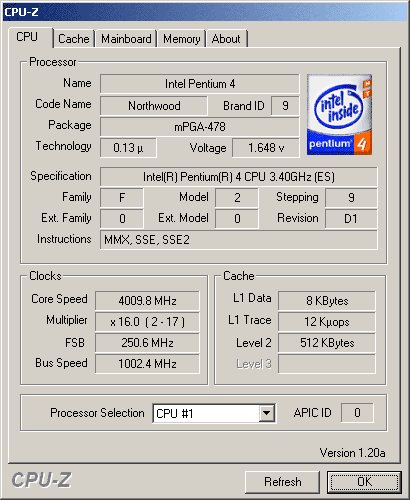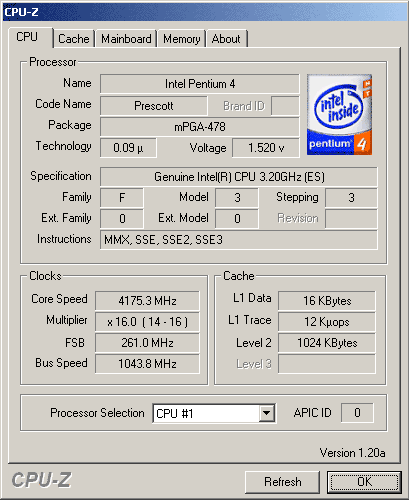P4 Northwood and Prescott Comparison at 4.1 GHz
Prescott Up To 4.17 GHz, Northwood With 4 GHz Maximum
The Pentium 4 Northwood reached a maximum of 4 GHz with a modicum of stability. Above this, signs of failure appeared in the form of Windows errors.
We used two conventional 3.2 GHz processors that can be bought at retail channels for this test. They thus reflect performance results that can be achieved with commercially available processors.
The following table shows the all configurations we benchmarked and tested:
| Header Cell - Column 0 | CPU Clock | FSB Clock | CPU Voltage |
|---|---|---|---|
| P4 Northwood | 3,207 MHz | 200.5 MHz | 1.55 V |
| P4 Northwood | 3,535 MHz | 220.9 MHz | 1.55 V |
| P4 Northwood | 3,695 MHz | 230.9 MHz | 1.55 V |
| P4 Northwood | 3,866 MHz | 241.7 MHz | 1.575 V |
| P4 Northwood | 4,009 MHz | 250.6 MHz | 1.625 V |
| P4 Prescott | 3,207 MHz | 200.5 MHz | 1.375 V |
| P4 Prescott | 3,535 MHz | 220.9 MHz | 1.375 V |
| P4 Prescott | 3,695 MHz | 230.9 MHz | 1.375 V |
| P4 Prescott | 3,866 MHz | 241.7 MHz | 1.40 V |
| P4 Prescott | 4,009 MHz | 250.6 MHz | 1.425 V |
| P4 Prescott | 4,149 MHz | 259.4 MHz | 1.50 V |
In order for the processors to remain stable at 3.8 GHz and higher clock speeds, a compressor cooling system was required. The processor cores' voltages, which increased drastically at 4 GHz, produced a clear rise in thermal power - without the VapoChill the processor could not have handled the thermal power of well over 100 watts.
The P4 Prescott gained an edge over the Northwood with a somewhat higher maximum speed: 4.175 MHz, which indicates its potential.
Get Tom's Hardware's best news and in-depth reviews, straight to your inbox.
Current page: Prescott Up To 4.17 GHz, Northwood With 4 GHz Maximum
Prev Page RAM: OCZ PC4000 Dual Channel Gold Next Page Test System
Patrick Schmid was the editor-in-chief for Tom's Hardware from 2005 to 2006. He wrote numerous articles on a wide range of hardware topics, including storage, CPUs, and system builds.

